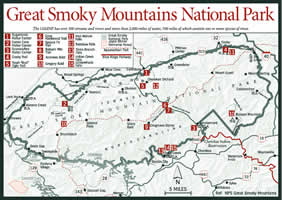

The GSMNP has 1,008 developed sites in 10 campgrounds maintained by the Park Service. The developed campgrounds have tent sites, limited trailer space, water, fireplaces, picnic tables, and restrooms with flush toilets, but there are no hot showers or hookups for trailers and RVs.
Sewage disposal stations are at Smokemont, Cades Cove, Deep Creek, and Cosby campgrounds and across the road from the Sugarlands Visitors Center. They are not available for use in the winter.
Reservations are required from May 15 through October 31 for year-round campgrounds including Cades Cove, Elkmont, and Smokemont. The length of stay is limited to seven consecutive days during the reservation period. Otherwise, the maximum stay is 14 days. You may call (800) 365-2267 for these reservations up to 12 weeks in advance, otherwise the system operates on a first-come, first-serve basis. The number of campsites available in year-round campgrounds decreases seasonally.
[Fig. 45] Located in the extreme northeastern corner on the North Carolina side of the GSMNP, this was one of the areas extensively logged before the formation of the park. Under the aegis of the Park Service, the area has recovered and Big Creek is one of the prettiest streams in the Smokies. A trail originating in the campground follows the creek as it cascades over massive boulders into deep plunge pools.
[Fig.
45] Cosby has a lovely, relatively underutilized campground on the
northeastern edge of the park. Several hiking trails originate from the campground
including the Cosby Nature Trail, which is good for spring wildflower walks.
Little Cosby Creek, a lovely stream bordered by hemlocks, offers angling opportunities
for rainbow trout in its lower portions and access for tubing. It is restricted
above the Low Gap Trail crossing for protection of brookies. The Low Gap Trail
begins at the parking area to the left of the Cosby campground and crosses
Cosby Creek in less than 1 mile.

[Fig. 45] Elkmont is off Little River Road and is the closest campground to Gatlinburg. Although it was the site of extensive logging operations before the formation of the park, the Elkmont Campground is tree-shaded with many campsites located along the confluence of Jakes Creek and the Little River.
Fishing access is plentiful along Jake's Creek Trail, which begins about 0.4 mile beyond the abandoned Elkmont Summer Colony, a cluster of former vacation homes built in the 1920s and now property of the GSMNP.
Elkmont was also the site of the historic Wonderland Hotel, one of two facilities offering overnight accommodations inside the park. The GSMNP declined to renew the lease for the Wonderland in 1992. The building, which does not fall under protective guidelines, is targeted for eventual removal.
[Fig. 44] Cades Cove is on the western edge of the park and is one of three developed campgrounds open year-round. The campground provides easy access to horseback riding at the stable in Cades Cove, bicycle rental, hiking, and picnicking as well as fishing in Abrams Creek and visits to the historic structures and visitor center in Cades Cove (see Cades Cove, page 271).
[Fig. 45] Although it is the smallest campground on the Tennessee side of the park, it is one of the prettiest sites. The section of Abrams Creek near the campground offers excellent trout fishing in several long, deep pools. A steep walk up Little Bottoms Trail leads to Abrams Falls, a 25-foot cascade into a deep, trout-filled pool.
[Fig. 45] On the Western Foothills Parkway, Look Rock offers hiking and scenic overlooks.
[Fig. 48] Located in one of the most remote sections of the park, Cataloochee provides excellent access to trout fishing and hiking.

[Fig. 48] Balsam Mountain Campground sits 5,310 feet above sea level north of the Blue Ridge Parkway on the North Carolina side of the park. A nature trail originating at the campground introduces campers to life in the high reaches of the Smokies.
[Fig. 48] Smokemont is a lovely, shady campground on the southern edge of the park with many streamside sites. It is the largest campground on the North Carolina side of the park.
[Fig. 45] Deep Creek Campground is very popular with anglers because of its proximity to the Deep Creek Trail, which offers about 10 miles of access to good to excellent rainbow and brown trout fishing on Deep Creek. Horace Kephart, a noted author and early proponent of the park, frequented this area. There are several backcountry campsites along Deep Creek that are frequented by anglers also. The campground is within 2 miles of Juneywhank Falls, Indian Creek Falls, and Toms Branch Falls.
In addition to the developed campgrounds, there are 98 backcountry campsites and 16 trail shelters. All require a free use permit. Approximately 30 of the sites can be reserved up to one month in advance, and the remainder are first-come, first-serve sites. The latter may be obtained by self-registering at any ranger station. You may stay up to three consecutive nights at a campsite, but should plan to spend only one night at any shelter. Since some sites are rationed because of heavy use, it may be necessary to obtain permission to camp from the Backcountry Reservation Office.
Camping is permitted only at designated sites and shelters. The maximum camping party size is eight. You should not bathe or wash dishes with soap in any park stream. All water should be boiled for one minute before drinking. A small camp stove is a good idea since open fires are allowed only at designated campsites and only wood that is dead and on the ground may be collected. Food should be stored so that it is inaccessible to bears, and all food and trash must be packed out.
All rules and regulations are listed on the Great Smoky Mountains Trail Map available from the Great Smoky Mountain Natural History Association.
There are also automobile-accessible horse camps with primitive horse stalls that may be reserved up to 30 days in advance and used for a maximum of 7 days. Some of the sites are rationed due to heavy use. Horses are restricted to trails designated for horse use. They may not be left unattended or allowed to graze. All food must be packed in. Horses should not be tied within 100 feet of trail shelters, sleeping areas of campsites, or stream or water sources.